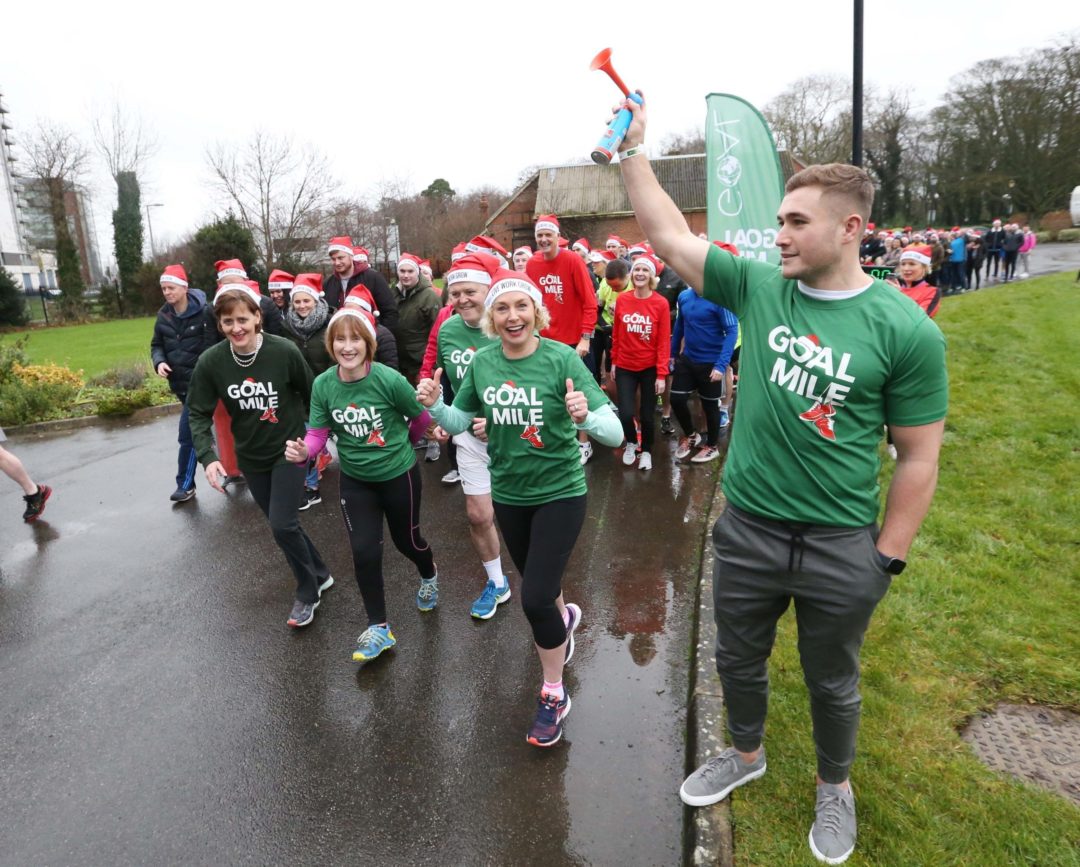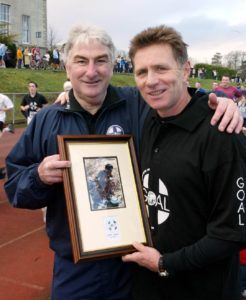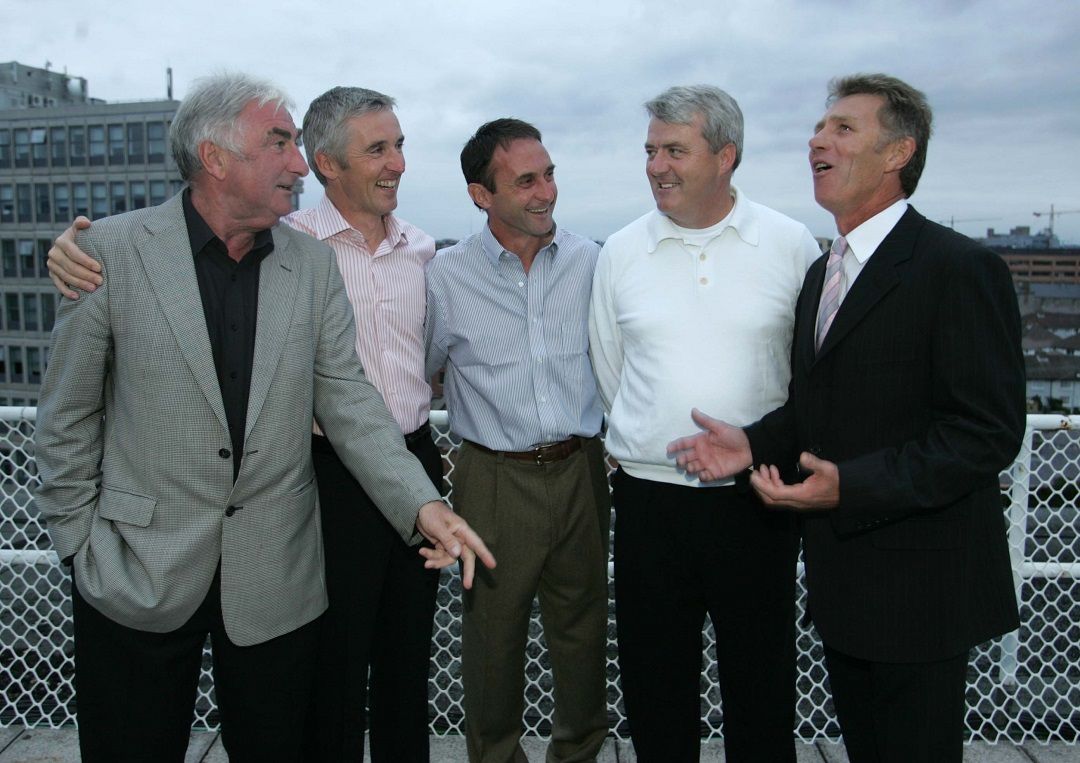 Stories
Stories
August 16, 2020 • 14 min read
In the summer of 1985, John O’Shea, the founder of GOAL, recruited four of Ireland’s famed middle-distance runners, Eamonn Coghlan, Frank O’Mara, Marcus O’Sullivan and Ray Flynn, to launch an attack on the world 4x1 mile-relay record. The idea was to raise money to respond to the famine in Ethiopia which was affecting the lives of six million people. The four athletes would later go on to set a world record. In this moving article in the Irish Times, Ian O’ Riordan looks back on that special evening, 35 years on.
The idea was to stage some sort of world record attempt on the grass track and raise a few quid towards the famine in Ethiopia. Truth is John O’Shea had no idea what it would become as he wandered into Trinity College 35 years ago this summer, except that he had to make it happen, and happen fast.
Here’s the scene of his light bulb moment: a small group of runners are tearing around the neatly cut green and white-lined grass track, the late Noel Carroll among them, a healthy crowd of spectators admiring their swift movements while finishing off their lunch in the sweet summer sun.
Might there be an idea in this?
O’Shea was already deeply compelled and utterly spurred – not long back from a trip to Ethiopia that spring of 1985, where the famine which made global headlines the previous Christmas was still ravaging among some six million people, the scenes of which had just further pressed Bob Geldof into putting on a benefit concert at Wembley Stadium called Live Aid.
By now the Ethiopian famine was also the central mission of O’Shea’s own Third World relief agency, set up in 1977 after first visiting the impoverished city of Calcutta and promptly returning with a £10,000 cash donation: he named it GOAL giving it a sporting edge in part because of his job as a sports reporter with the Evening Press, knowing full well too how sport can impact on charity, and sometimes vice versa.

Sport remains at the heart of GOAL fundraising. The GOAL Mile 2019 in Central Park, Leopardstown.
“Walking into Trinity that day, already well familiar with Noel Carroll and the lads running around College Park, my only objective was to raise money, as quickly as possible, without being exactly sure how to go about it,” says O’Shea, revisiting his idea 35 years on with a still lasting sense of urgency: whatever the idea, it had to happen fast.
“The famine in Ethiopia had a profound impact on me, having been one of the first western journalists to visit, seeing for myself the bones of six million people starving simultaneously. I was desperate, I was determined, and seeing the lads running around, and the potential to get a crowd in to watch, I got the idea of putting on some sort of running event there, bringing in some big names, going around with a bucket, collecting money that way.”
The runners
O’Shea already had his cast in mind: Eamonn Coghlan, the then world indoor mile record holder, with his 3:49.78, set in 1983; Ray Flynn, still the Irish mile record holder with his 3:49.77, set in 1982; Marcus O’Sullivan, the 23-year-old from Cork who just had run a 3:52.64 mile at the Cork City Sports that July; and Frank O’Mara from Limerick, also fast rising up the mile ranks and would run 3:51.06 a year later. Flynn, O’Sullivan and O’Mara had all run in the Los Angeles Olympics the year before, which Coghlan, the reigning world 5,000m champion from 1983, had missed through injury.
“I certainly wasn’t unaware of the fact, having a great interest in athletics and the mile, that we had four of the very best milers in the world. The fastest four we ever had. So my first idea was for the four of them to break some sort of mile record on the grass. Even if the sport had moved on from grass tracks, I thought that might work, would be something different.”
With that O’Shea ran the idea past Carroll, the two-time Olympian over 800m and then public relations officer for Dublin Corporation: “I leaned on Noel an awful lot, a super guy, and a great friend. I’d no problem making any sort of decision, but before signing off, I’d nearly always run it by Noel. He had this amazing understanding of what’s right and wrong. And I was in a game of what’s right and wrong, especially in places like Africa.
“Noel thought it was an okay idea, but said he’d look at the record books. I think he wanted it to be a half-mile record attempt, he was always so obsessed with the half-mile. When we started the GOAL Mile in 1982 he wanted it to be the GOAL Half-Mile. Then he comes back the next day and says he has an even better idea, that we’d go for the mile-relay record, which he’d seen had recently been set by New Zealand.”
It was a rarely run event, though no less engaging: four times a mile, in immediate succession, better still if each was run under four minutes – which is exactly what the New Zealand quartet had averaged in 1983, when setting the world record of 15:59.57 in Auckland, anchored by their former mile world record holder John Walker. The mile was also still perfectly in vogue, Britain’s Steve Cram lowering the world record to 3:46.32 to win the Dream Mile at the Bislett Games in Oslo that July of 1985.
“I was also knowledgeable enough to realise the record was well within the range of the four lads, that if they averaged a 3:58 mile, they’d break it easy enough. So we forget about the grass track, and moved the idea to the running track at Belfield, setting it up as a world record attempt. Which was a nice attraction, but really my objective was different, all about getting more money in the post to Ethiopia.”
Carroll sorted the use of the Belfield track, and O’Shea eyed up the evening of Saturday August 17th, relatively late and free in the season: or so he thought. Flynn, O’Sullivan and O’Mara were all based in Europe for the summer, set to run at the Weltklasse meeting in Zurich on August 21st (where, incidentally, the American Mary Slaney Decker would lower the women’s mile world record to 4:16.71).
Getting the team together
“Almost all my ideas came overnight like that, but we had to act fast, so I got my arse over to Zurich, and met with the three lads. They weren’t immediately sold, told me about training plans, races, this and that. And I told them I wasn’t leaving until they said yes, that millions of people were starving in Ethiopia and you’re worried about f***ing training? I sold them pretty quickly on that. But that’s the kind of mood I was in. I would have dragged people into Belfield that night, the four lads had no chance of getting off.”

John O’Shea presents Eamonn Coughlan with an award for running the GOAL Mile every Christmas Day for 21 years in 2002.
For the mile relay record attempt, O’Shea and Carroll planned to pull together four teams of four runners each, Ireland A and B, plus two more club teams. There was still a minor obstacle: Coghlan, one of O’Shea’s own sporting heroes from Dublin, was still recovering from a freak back injury, sustained at the beginning of the season on the steps of his then home in Rye, upstate New York. No way was Coghlan fit to run, or so he said, so O’Shea had to try another trick.
“From day one I wanted Coghlan, even if he had to be pushed around in a wheelchair. Then he tells me he’s in the worse shape of his life, could only run around 4:16. And this was two days before the race. So I rang John Treacy, who was on the B team, and gave him the spot on the A team. Treacy said he’d run four minutes flat, no problem, that was good enough for me. I reckoned the other three could make up for it.
“So I rang Eamonn back and told him he was off the hook, and he could run on the B team. I can’t repeat what Coghlan said, except to say the phone suddenly went dead. I’d enough to worry about at that point, trying to organise the rest of the night. And the next day Coghlan arrives up to my house, tells me to forget Treacy, that he was running on the A team. Pride had got to him.”
Which is more or less exactly what happened – as Coghlan takes up the baton and the story 35 years later: “I was just back jogging at that stage, after months of injury, and out of nowhere John rang me up, and started twisting my arm, telling me he already has Marcus, Frank and Ray.
“I kept telling him I wasn’t in shape. I was only jogging about a month, after a back injury, which still hurts me today by the way. John keeps saying ‘come on Coghlan, get the f*** down here, the team needs you . . .’ I knew I wasn’t in shape, no way was I running, and then John comes back again and tells me to f*** off, he’s got John Treacy to run instead.
“Then Noel Carroll came on the phone, and this is the day before, and I’d just gone out and done a long run, 15 miles or so. Noel is a bit more diplomatic, saying it wouldn’t be the same if the record was broken and I wasn’t on the team. So I go back to John O’Shea the next day, yeah, and said ‘okay, I’ll do it’.”
It was hastily billed as the GOAL National Sports Day, with a few novelty curtain-raisers to the main event, including a devil-take-the-hindmost cycling race featuring Stephen Roche, Seán Kelly and Martin Earley – three Irish stars of the 1985 Tour de France: Roche had finished third behind Bernard Hinault and Greg LeMond, Kelly finished fourth and won the green jersey, with Earley in 60th. O’Shea had no problem convincing them to lend a wheel.
“I have few talents, but I could get Jesus Christ to go drinking with the devil, if I knew it could some raise money. So getting Roche and Kelly was no bother. I know I haven’t won many prizes for diplomacy either, so Noel kept us all from killing each other too, and used his diplomatic skills to get everyone at Belfield on board. Although BLE (the governing body of Irish athletics at the time) definitely weren’t much help. Let’s just say they tried to make life difficult.”
Setting the record
Conditions for the record attempt were perfect, but now the pressure was on. Coghlan, for one, suddenly realising what he’d let himself in for.
“I remember arriving down at Belfield, and it was still quiet enough, and I go for a warm-up in the back fields, with the other three lads, Marcus, Frank and Ray. By the time we got back there were all these people buzzing around the track, the place was packed out, and I’m like ‘s***’, I’ve got to make this happen.
“Then O’Shea puts John Treacy up against me, in the first leg, and I just remember it as one of the toughest, hardest runs I’ve ever had to make. There were a few, but that still stands out as clear as daylight. I just wasn’t in shape, but no way was I letting Treacy beat me. So it was pride, no doubt about it, and pure determination. Treacy and I were great rivals, had huge respect for each other, but no way was I letting him beat me over the mile. I also knew what was on the line, and putting me in with John Treacy, definitely worked. I just got there ahead of him, just knowing on instinct how to run the mile, I suppose.”
After Coghlan clocked his 4:00.20, just a stride ahead of Treacy, he passed off to O’Sullivan, who dropped in a 3:55.30 and with that immediately put them inside world record pace. O’Mara came next with his 3:56.60, and when Flynn brought them home with his 3:56.98, run completely solo, they finished in 15:49.08 – over 10 seconds inside the New Zealand mark.
Jimmy Magee and Brendan O’Reilly provided live commentary – and all four milers later credited the support of the crowd, which on the top bend and homestretch were eight or nine deep, close to 8,000 in all: O’Shea’s idea had become bigger than he ever imagined.
“I remember early on in the evening, there was no one there, and then suddenly they just started pouring in, and you couldn’t get near the track. The atmosphere was incredible, and the four lads were oozing desire. And true to their word, Coghlan and Treacy both passed the line in four minutes flat.

John O’Shea, Frank O’Mara, Marcus O’Sullivan, Ray Flynn and Eamonn Coghlan celebrate the 21st anniversary of the relay in 2006.
“There was no gate, because Belfield was so open, so we had our ‘Goalies’ going around with buckets, taking donations, and by the end of the night had collected around £25,000, with more coming in afterwards, bigger donations, actually.”
Despite his initial objective, the mile relay record attempt went far beyond raising a few quid towards the famine in Ethiopia: it still resonates deeply with O’Shea 35 years on, and not just because the record still stands intact.
“Irish athletes so rarely got the chance to show their wears here. Even the likes of Sonia O’Sullivan, in Cork maybe, but rarely in front of their own country. These were four phenomenal athletes, and albeit they had to do what they did in foreign fields, they deserved this adulation at home.”
They were far from finished: Coghlan won two more Wanamaker Miles, including a record seventh in 1987, ran a world indoor record over 2,000m that same year, and in 1994 became the first man in history to run a sub-four minute mile over the age of 40. O’Sullivan went on to win three World Indoor 1,500m titles, and O’Mara won two over 3,000m, and Flynn’s mile and 1,500m record of 3:33.5 also still stands 38 years later. They’re still four of the five fastest Irish milers in history, only Mark Carroll splitting them with his 3:50.62, run in 2000.
“We all got together again in Dublin a few years back,” says O’Shea, “and Marcus said that while he had a great career, he reckoned that night probably gave him the greatest pleasure. For Ray Flynn too, the adoration he got that night, our fastest ever miler, and yet hardly no one in Ireland ever saw him run. He could have walked down any street in Ireland and no one would have known him. Even at home in Longford.
“And forget about his world indoor record, Coghlan’s four-flat that night was one of his greatest ever runs. He was in bits afterwards, ran that on practically no training. And of course there should be a mark or some tribute at Belfield, the last world record track in the country, if they hadn’t gone and dug it up.”
A fresh challenge?
And perhaps a reminder too for a sport looking for fresh ideas in the aftermath of Covid-19, might it be a time for a fresh record attempt for another worthy cause? Only four milers, capable of averaging around a 3.57.25 mile, need apply.
Coghlan has a few suggestions on that note: “There have been a few record attempts since, from a Kenyan team, a Nike Oregon outfit, and they all fell short. Say if you got the three Ingebrigtsen brothers from Norway, Henrik, Filip and Jakob, plus one other from the country, it would be a very interesting gig for World Athletics. Maybe make it one of those virtual, reality TV type races.
“Or say get 10 members of an Irish athletics club, get them to run 176 yards, so that’s 1,760 yards, which is a mile, and make that the relay. It would be interesting to see can they do it. People can still relate to the mile.
“That night certainly left its mark. And while we were probably household names around the world at that stage, it was rare for the four of us to run at home together, in front of a home crowd. Plus it turned out to be one of the iconic sporting occasions in Ireland.”
With special thanks to The Irish Times for permission to reproduce this article.
Signing up to Jersey Day is simple. Just complete the registration form on jerseyday.org or email your interest to jerseyday@goal.ie.
